Analyzing Negative Externalities: Nepal's Brick Industry & Government
VerifiedAdded on 2023/06/07
|19
|4712
|420
Case Study
AI Summary
This case study delves into the concept of negative externalities, using the brick industry in Kathmandu Valley, Nepal, as a prime example. It explains how negative externalities, such as air and noise pollution, lead to market failures by not reflecting the true social costs of production. The study analyzes the impact of the brick industry on the environment and public health in Nepal, highlighting the role of outdated technologies in exacerbating pollution. Furthermore, it examines the government's efforts to address these externalities through pollution taxes and regulatory policies. The analysis includes supply and demand diagrams to illustrate the effects of these interventions. The case study also touches upon the market structure of the brick industry and evaluates its efficiency, considering the allocation of resources and market outcomes. The Coase Theorem is mentioned to explain the impact of pollution tax. The document is contributed by a student and available on Desklib, a platform offering study tools and resources for students.
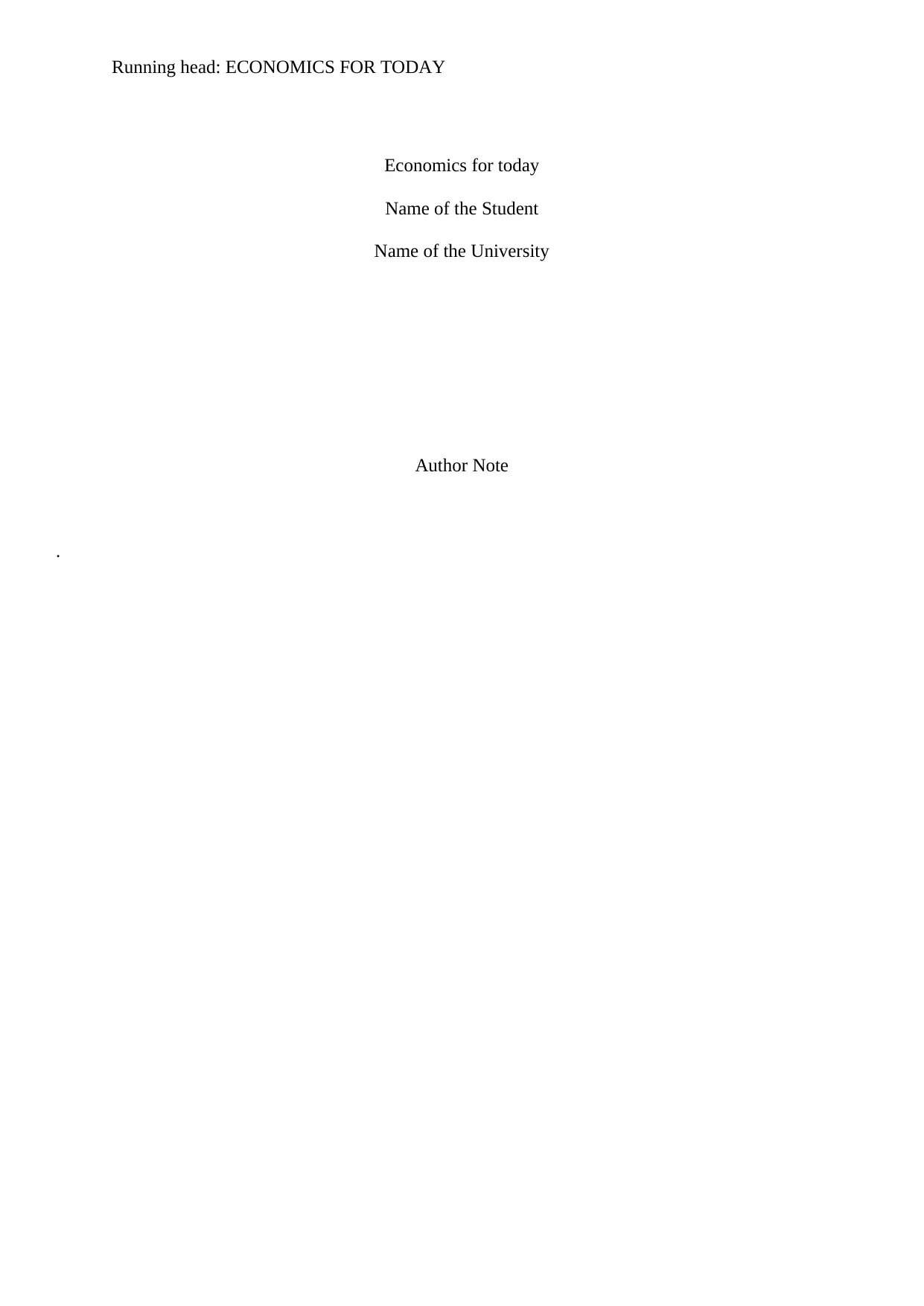
Running head: ECONOMICS FOR TODAY
Economics for today
Name of the Student
Name of the University
Author Note
.
Economics for today
Name of the Student
Name of the University
Author Note
.
Paraphrase This Document
Need a fresh take? Get an instant paraphrase of this document with our AI Paraphraser
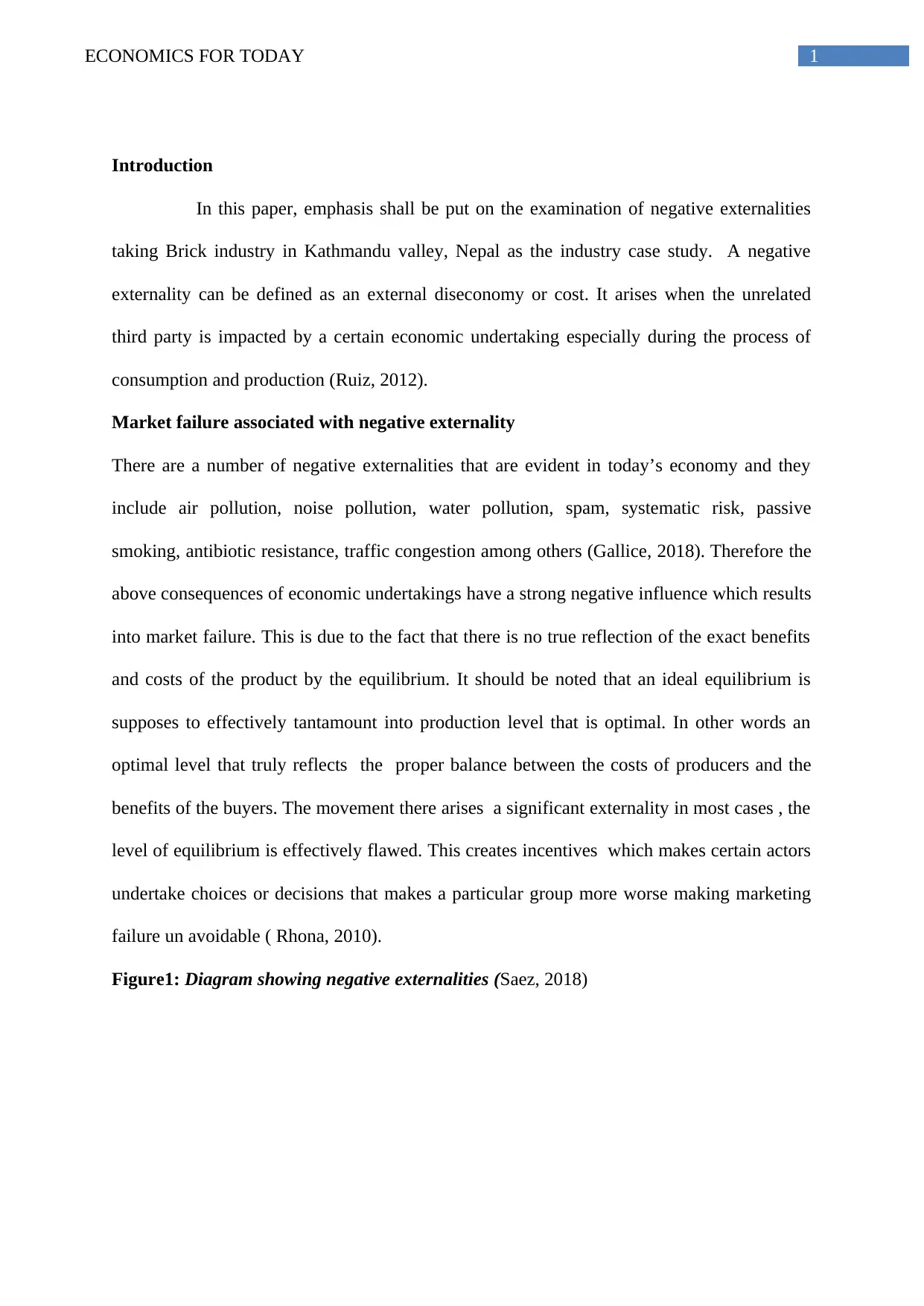
1ECONOMICS FOR TODAY
Introduction
In this paper, emphasis shall be put on the examination of negative externalities
taking Brick industry in Kathmandu valley, Nepal as the industry case study. A negative
externality can be defined as an external diseconomy or cost. It arises when the unrelated
third party is impacted by a certain economic undertaking especially during the process of
consumption and production (Ruiz, 2012).
Market failure associated with negative externality
There are a number of negative externalities that are evident in today’s economy and they
include air pollution, noise pollution, water pollution, spam, systematic risk, passive
smoking, antibiotic resistance, traffic congestion among others (Gallice, 2018). Therefore the
above consequences of economic undertakings have a strong negative influence which results
into market failure. This is due to the fact that there is no true reflection of the exact benefits
and costs of the product by the equilibrium. It should be noted that an ideal equilibrium is
supposes to effectively tantamount into production level that is optimal. In other words an
optimal level that truly reflects the proper balance between the costs of producers and the
benefits of the buyers. The movement there arises a significant externality in most cases , the
level of equilibrium is effectively flawed. This creates incentives which makes certain actors
undertake choices or decisions that makes a particular group more worse making marketing
failure un avoidable ( Rhona, 2010).
Figure1: Diagram showing negative externalities (Saez, 2018)
Introduction
In this paper, emphasis shall be put on the examination of negative externalities
taking Brick industry in Kathmandu valley, Nepal as the industry case study. A negative
externality can be defined as an external diseconomy or cost. It arises when the unrelated
third party is impacted by a certain economic undertaking especially during the process of
consumption and production (Ruiz, 2012).
Market failure associated with negative externality
There are a number of negative externalities that are evident in today’s economy and they
include air pollution, noise pollution, water pollution, spam, systematic risk, passive
smoking, antibiotic resistance, traffic congestion among others (Gallice, 2018). Therefore the
above consequences of economic undertakings have a strong negative influence which results
into market failure. This is due to the fact that there is no true reflection of the exact benefits
and costs of the product by the equilibrium. It should be noted that an ideal equilibrium is
supposes to effectively tantamount into production level that is optimal. In other words an
optimal level that truly reflects the proper balance between the costs of producers and the
benefits of the buyers. The movement there arises a significant externality in most cases , the
level of equilibrium is effectively flawed. This creates incentives which makes certain actors
undertake choices or decisions that makes a particular group more worse making marketing
failure un avoidable ( Rhona, 2010).
Figure1: Diagram showing negative externalities (Saez, 2018)
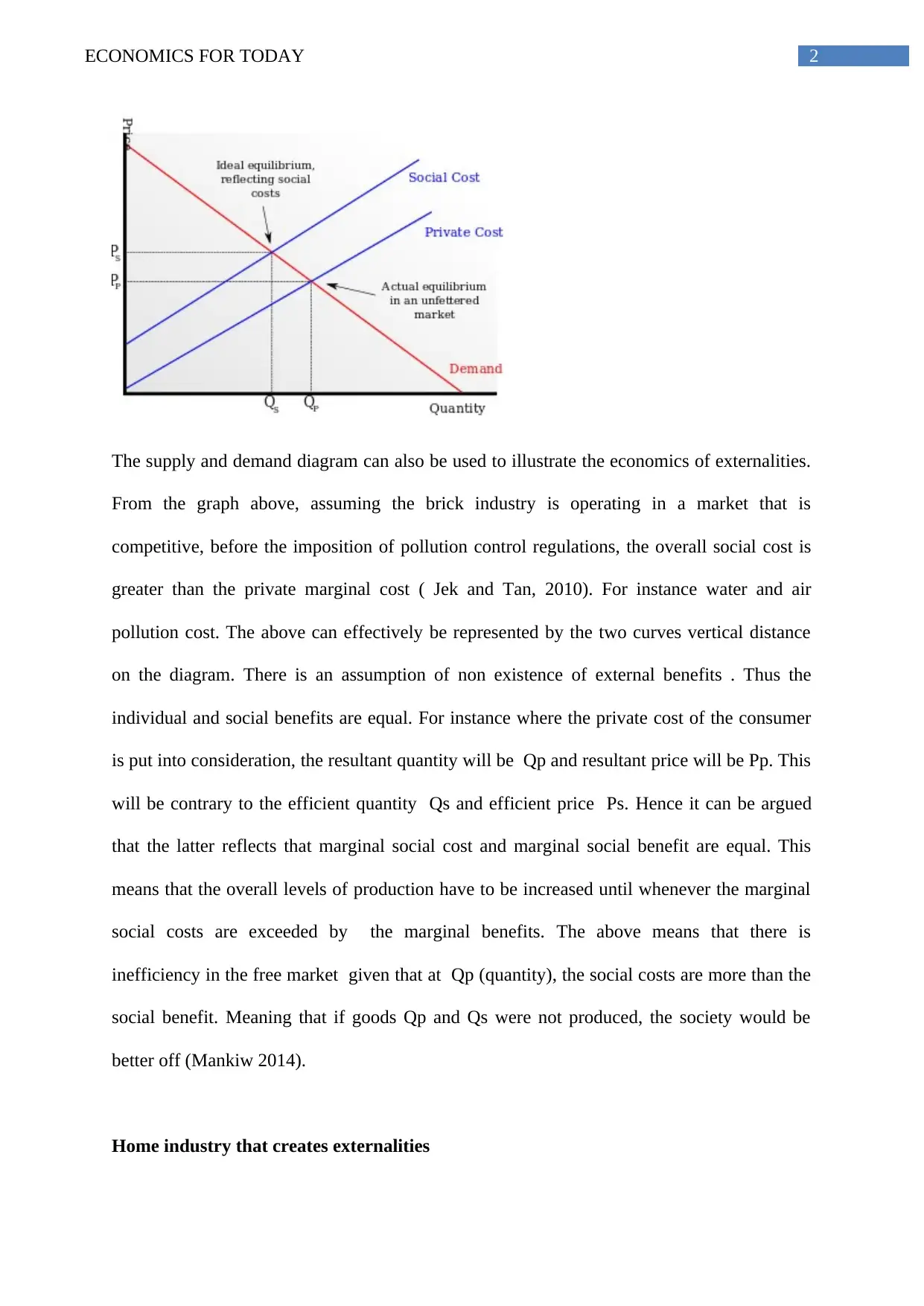
2ECONOMICS FOR TODAY
The supply and demand diagram can also be used to illustrate the economics of externalities.
From the graph above, assuming the brick industry is operating in a market that is
competitive, before the imposition of pollution control regulations, the overall social cost is
greater than the private marginal cost ( Jek and Tan, 2010). For instance water and air
pollution cost. The above can effectively be represented by the two curves vertical distance
on the diagram. There is an assumption of non existence of external benefits . Thus the
individual and social benefits are equal. For instance where the private cost of the consumer
is put into consideration, the resultant quantity will be Qp and resultant price will be Pp. This
will be contrary to the efficient quantity Qs and efficient price Ps. Hence it can be argued
that the latter reflects that marginal social cost and marginal social benefit are equal. This
means that the overall levels of production have to be increased until whenever the marginal
social costs are exceeded by the marginal benefits. The above means that there is
inefficiency in the free market given that at Qp (quantity), the social costs are more than the
social benefit. Meaning that if goods Qp and Qs were not produced, the society would be
better off (Mankiw 2014).
Home industry that creates externalities
The supply and demand diagram can also be used to illustrate the economics of externalities.
From the graph above, assuming the brick industry is operating in a market that is
competitive, before the imposition of pollution control regulations, the overall social cost is
greater than the private marginal cost ( Jek and Tan, 2010). For instance water and air
pollution cost. The above can effectively be represented by the two curves vertical distance
on the diagram. There is an assumption of non existence of external benefits . Thus the
individual and social benefits are equal. For instance where the private cost of the consumer
is put into consideration, the resultant quantity will be Qp and resultant price will be Pp. This
will be contrary to the efficient quantity Qs and efficient price Ps. Hence it can be argued
that the latter reflects that marginal social cost and marginal social benefit are equal. This
means that the overall levels of production have to be increased until whenever the marginal
social costs are exceeded by the marginal benefits. The above means that there is
inefficiency in the free market given that at Qp (quantity), the social costs are more than the
social benefit. Meaning that if goods Qp and Qs were not produced, the society would be
better off (Mankiw 2014).
Home industry that creates externalities
⊘ This is a preview!⊘
Do you want full access?
Subscribe today to unlock all pages.

Trusted by 1+ million students worldwide
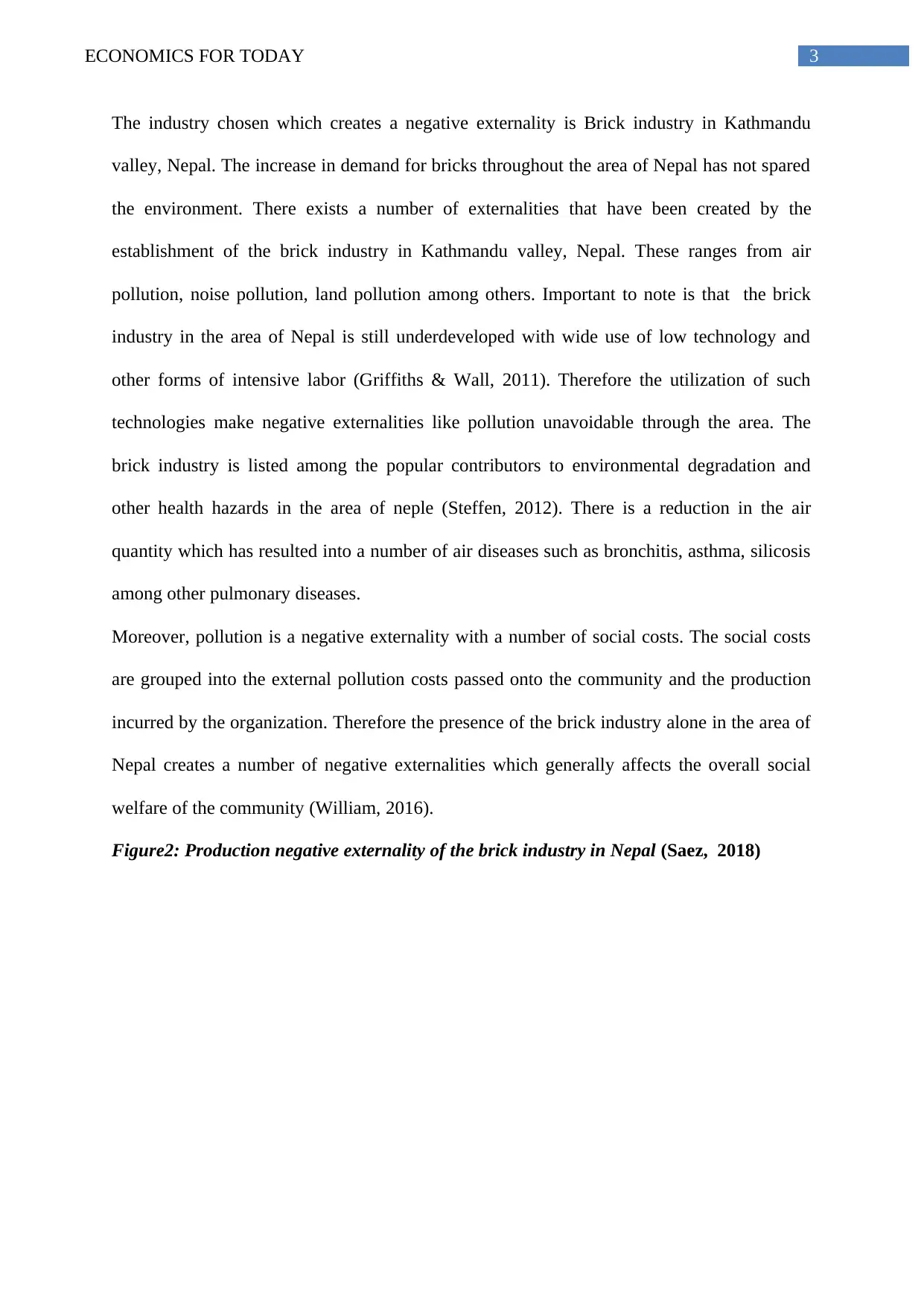
3ECONOMICS FOR TODAY
The industry chosen which creates a negative externality is Brick industry in Kathmandu
valley, Nepal. The increase in demand for bricks throughout the area of Nepal has not spared
the environment. There exists a number of externalities that have been created by the
establishment of the brick industry in Kathmandu valley, Nepal. These ranges from air
pollution, noise pollution, land pollution among others. Important to note is that the brick
industry in the area of Nepal is still underdeveloped with wide use of low technology and
other forms of intensive labor (Griffiths & Wall, 2011). Therefore the utilization of such
technologies make negative externalities like pollution unavoidable through the area. The
brick industry is listed among the popular contributors to environmental degradation and
other health hazards in the area of neple (Steffen, 2012). There is a reduction in the air
quantity which has resulted into a number of air diseases such as bronchitis, asthma, silicosis
among other pulmonary diseases.
Moreover, pollution is a negative externality with a number of social costs. The social costs
are grouped into the external pollution costs passed onto the community and the production
incurred by the organization. Therefore the presence of the brick industry alone in the area of
Nepal creates a number of negative externalities which generally affects the overall social
welfare of the community (William, 2016).
Figure2: Production negative externality of the brick industry in Nepal (Saez, 2018)
The industry chosen which creates a negative externality is Brick industry in Kathmandu
valley, Nepal. The increase in demand for bricks throughout the area of Nepal has not spared
the environment. There exists a number of externalities that have been created by the
establishment of the brick industry in Kathmandu valley, Nepal. These ranges from air
pollution, noise pollution, land pollution among others. Important to note is that the brick
industry in the area of Nepal is still underdeveloped with wide use of low technology and
other forms of intensive labor (Griffiths & Wall, 2011). Therefore the utilization of such
technologies make negative externalities like pollution unavoidable through the area. The
brick industry is listed among the popular contributors to environmental degradation and
other health hazards in the area of neple (Steffen, 2012). There is a reduction in the air
quantity which has resulted into a number of air diseases such as bronchitis, asthma, silicosis
among other pulmonary diseases.
Moreover, pollution is a negative externality with a number of social costs. The social costs
are grouped into the external pollution costs passed onto the community and the production
incurred by the organization. Therefore the presence of the brick industry alone in the area of
Nepal creates a number of negative externalities which generally affects the overall social
welfare of the community (William, 2016).
Figure2: Production negative externality of the brick industry in Nepal (Saez, 2018)
Paraphrase This Document
Need a fresh take? Get an instant paraphrase of this document with our AI Paraphraser
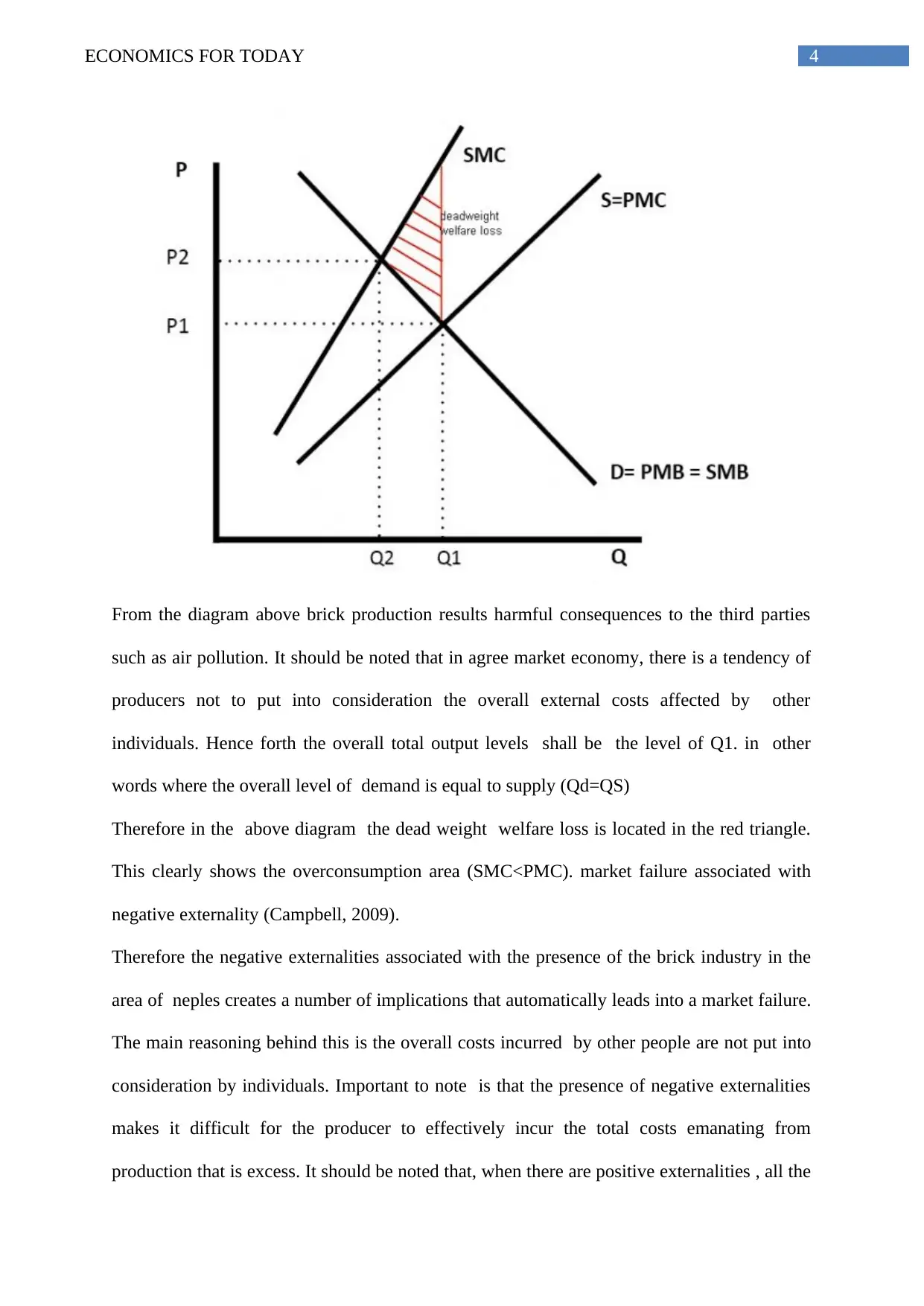
4ECONOMICS FOR TODAY
From the diagram above brick production results harmful consequences to the third parties
such as air pollution. It should be noted that in agree market economy, there is a tendency of
producers not to put into consideration the overall external costs affected by other
individuals. Hence forth the overall total output levels shall be the level of Q1. in other
words where the overall level of demand is equal to supply (Qd=QS)
Therefore in the above diagram the dead weight welfare loss is located in the red triangle.
This clearly shows the overconsumption area (SMC<PMC). market failure associated with
negative externality (Campbell, 2009).
Therefore the negative externalities associated with the presence of the brick industry in the
area of neples creates a number of implications that automatically leads into a market failure.
The main reasoning behind this is the overall costs incurred by other people are not put into
consideration by individuals. Important to note is that the presence of negative externalities
makes it difficult for the producer to effectively incur the total costs emanating from
production that is excess. It should be noted that, when there are positive externalities , all the
From the diagram above brick production results harmful consequences to the third parties
such as air pollution. It should be noted that in agree market economy, there is a tendency of
producers not to put into consideration the overall external costs affected by other
individuals. Hence forth the overall total output levels shall be the level of Q1. in other
words where the overall level of demand is equal to supply (Qd=QS)
Therefore in the above diagram the dead weight welfare loss is located in the red triangle.
This clearly shows the overconsumption area (SMC<PMC). market failure associated with
negative externality (Campbell, 2009).
Therefore the negative externalities associated with the presence of the brick industry in the
area of neples creates a number of implications that automatically leads into a market failure.
The main reasoning behind this is the overall costs incurred by other people are not put into
consideration by individuals. Important to note is that the presence of negative externalities
makes it difficult for the producer to effectively incur the total costs emanating from
production that is excess. It should be noted that, when there are positive externalities , all the
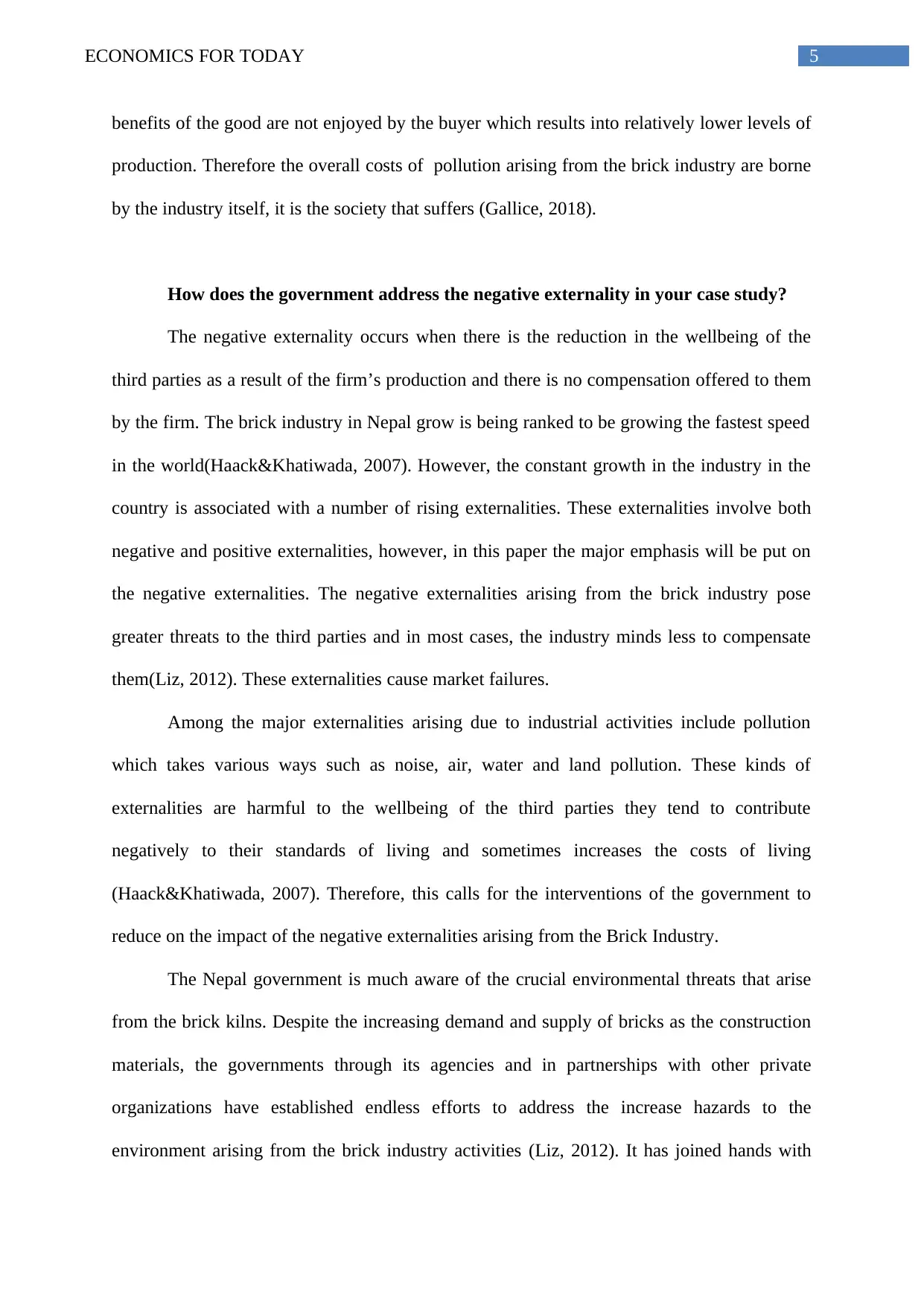
5ECONOMICS FOR TODAY
benefits of the good are not enjoyed by the buyer which results into relatively lower levels of
production. Therefore the overall costs of pollution arising from the brick industry are borne
by the industry itself, it is the society that suffers (Gallice, 2018).
How does the government address the negative externality in your case study?
The negative externality occurs when there is the reduction in the wellbeing of the
third parties as a result of the firm’s production and there is no compensation offered to them
by the firm. The brick industry in Nepal grow is being ranked to be growing the fastest speed
in the world(Haack&Khatiwada, 2007). However, the constant growth in the industry in the
country is associated with a number of rising externalities. These externalities involve both
negative and positive externalities, however, in this paper the major emphasis will be put on
the negative externalities. The negative externalities arising from the brick industry pose
greater threats to the third parties and in most cases, the industry minds less to compensate
them(Liz, 2012). These externalities cause market failures.
Among the major externalities arising due to industrial activities include pollution
which takes various ways such as noise, air, water and land pollution. These kinds of
externalities are harmful to the wellbeing of the third parties they tend to contribute
negatively to their standards of living and sometimes increases the costs of living
(Haack&Khatiwada, 2007). Therefore, this calls for the interventions of the government to
reduce on the impact of the negative externalities arising from the Brick Industry.
The Nepal government is much aware of the crucial environmental threats that arise
from the brick kilns. Despite the increasing demand and supply of bricks as the construction
materials, the governments through its agencies and in partnerships with other private
organizations have established endless efforts to address the increase hazards to the
environment arising from the brick industry activities (Liz, 2012). It has joined hands with
benefits of the good are not enjoyed by the buyer which results into relatively lower levels of
production. Therefore the overall costs of pollution arising from the brick industry are borne
by the industry itself, it is the society that suffers (Gallice, 2018).
How does the government address the negative externality in your case study?
The negative externality occurs when there is the reduction in the wellbeing of the
third parties as a result of the firm’s production and there is no compensation offered to them
by the firm. The brick industry in Nepal grow is being ranked to be growing the fastest speed
in the world(Haack&Khatiwada, 2007). However, the constant growth in the industry in the
country is associated with a number of rising externalities. These externalities involve both
negative and positive externalities, however, in this paper the major emphasis will be put on
the negative externalities. The negative externalities arising from the brick industry pose
greater threats to the third parties and in most cases, the industry minds less to compensate
them(Liz, 2012). These externalities cause market failures.
Among the major externalities arising due to industrial activities include pollution
which takes various ways such as noise, air, water and land pollution. These kinds of
externalities are harmful to the wellbeing of the third parties they tend to contribute
negatively to their standards of living and sometimes increases the costs of living
(Haack&Khatiwada, 2007). Therefore, this calls for the interventions of the government to
reduce on the impact of the negative externalities arising from the Brick Industry.
The Nepal government is much aware of the crucial environmental threats that arise
from the brick kilns. Despite the increasing demand and supply of bricks as the construction
materials, the governments through its agencies and in partnerships with other private
organizations have established endless efforts to address the increase hazards to the
environment arising from the brick industry activities (Liz, 2012). It has joined hands with
⊘ This is a preview!⊘
Do you want full access?
Subscribe today to unlock all pages.

Trusted by 1+ million students worldwide
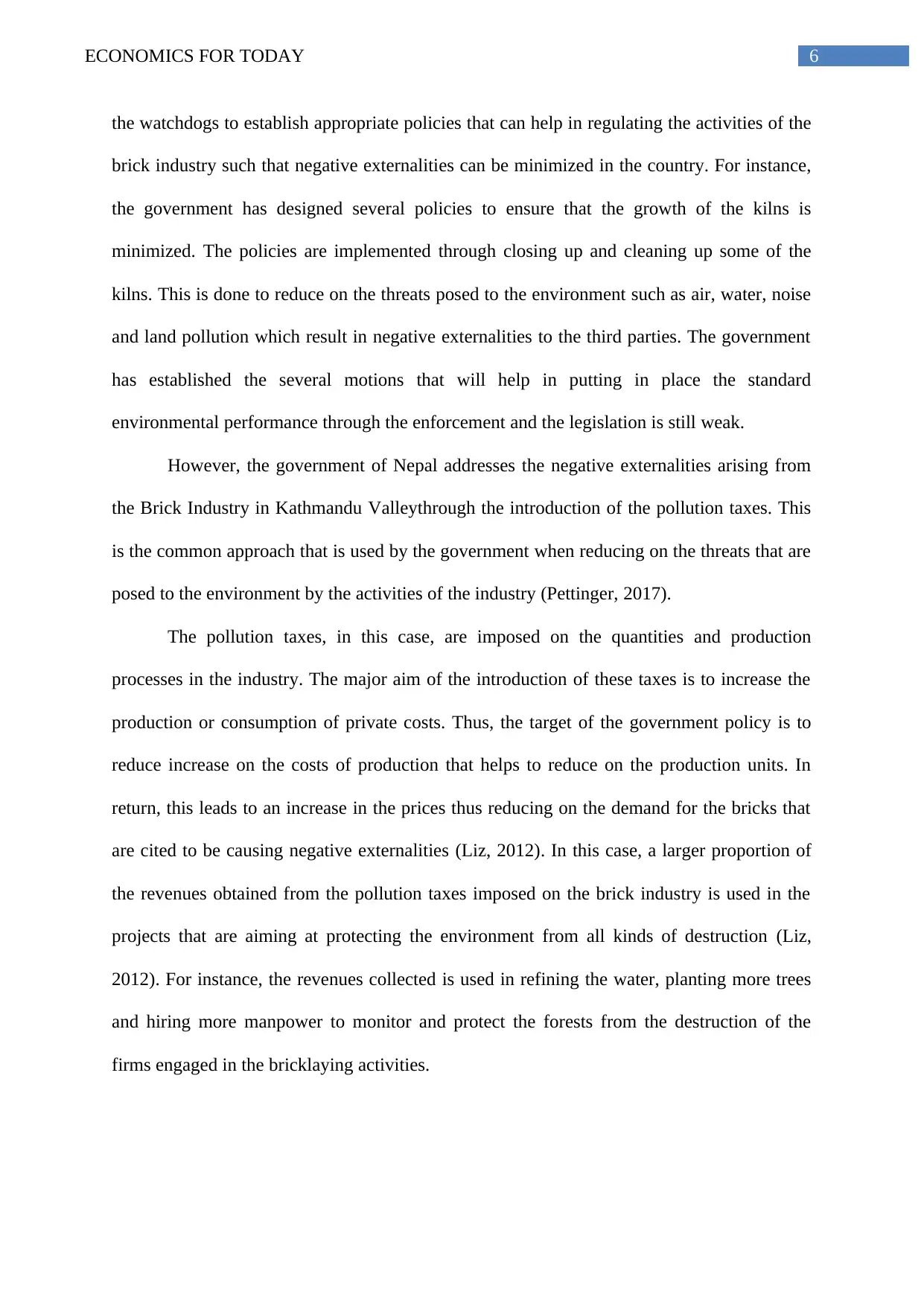
6ECONOMICS FOR TODAY
the watchdogs to establish appropriate policies that can help in regulating the activities of the
brick industry such that negative externalities can be minimized in the country. For instance,
the government has designed several policies to ensure that the growth of the kilns is
minimized. The policies are implemented through closing up and cleaning up some of the
kilns. This is done to reduce on the threats posed to the environment such as air, water, noise
and land pollution which result in negative externalities to the third parties. The government
has established the several motions that will help in putting in place the standard
environmental performance through the enforcement and the legislation is still weak.
However, the government of Nepal addresses the negative externalities arising from
the Brick Industry in Kathmandu Valleythrough the introduction of the pollution taxes. This
is the common approach that is used by the government when reducing on the threats that are
posed to the environment by the activities of the industry (Pettinger, 2017).
The pollution taxes, in this case, are imposed on the quantities and production
processes in the industry. The major aim of the introduction of these taxes is to increase the
production or consumption of private costs. Thus, the target of the government policy is to
reduce increase on the costs of production that helps to reduce on the production units. In
return, this leads to an increase in the prices thus reducing on the demand for the bricks that
are cited to be causing negative externalities (Liz, 2012). In this case, a larger proportion of
the revenues obtained from the pollution taxes imposed on the brick industry is used in the
projects that are aiming at protecting the environment from all kinds of destruction (Liz,
2012). For instance, the revenues collected is used in refining the water, planting more trees
and hiring more manpower to monitor and protect the forests from the destruction of the
firms engaged in the bricklaying activities.
the watchdogs to establish appropriate policies that can help in regulating the activities of the
brick industry such that negative externalities can be minimized in the country. For instance,
the government has designed several policies to ensure that the growth of the kilns is
minimized. The policies are implemented through closing up and cleaning up some of the
kilns. This is done to reduce on the threats posed to the environment such as air, water, noise
and land pollution which result in negative externalities to the third parties. The government
has established the several motions that will help in putting in place the standard
environmental performance through the enforcement and the legislation is still weak.
However, the government of Nepal addresses the negative externalities arising from
the Brick Industry in Kathmandu Valleythrough the introduction of the pollution taxes. This
is the common approach that is used by the government when reducing on the threats that are
posed to the environment by the activities of the industry (Pettinger, 2017).
The pollution taxes, in this case, are imposed on the quantities and production
processes in the industry. The major aim of the introduction of these taxes is to increase the
production or consumption of private costs. Thus, the target of the government policy is to
reduce increase on the costs of production that helps to reduce on the production units. In
return, this leads to an increase in the prices thus reducing on the demand for the bricks that
are cited to be causing negative externalities (Liz, 2012). In this case, a larger proportion of
the revenues obtained from the pollution taxes imposed on the brick industry is used in the
projects that are aiming at protecting the environment from all kinds of destruction (Liz,
2012). For instance, the revenues collected is used in refining the water, planting more trees
and hiring more manpower to monitor and protect the forests from the destruction of the
firms engaged in the bricklaying activities.
Paraphrase This Document
Need a fresh take? Get an instant paraphrase of this document with our AI Paraphraser
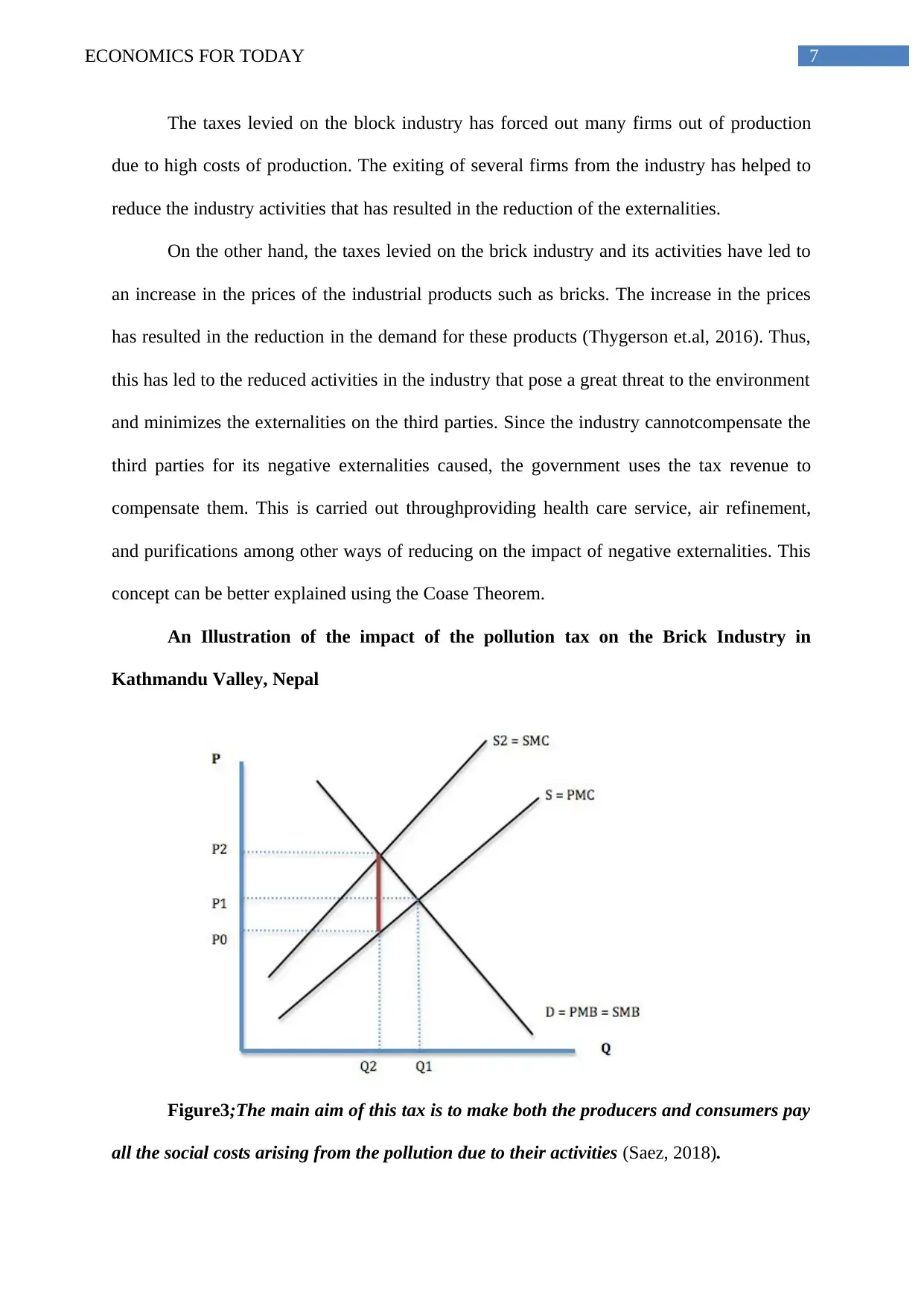
7ECONOMICS FOR TODAY
The taxes levied on the block industry has forced out many firms out of production
due to high costs of production. The exiting of several firms from the industry has helped to
reduce the industry activities that has resulted in the reduction of the externalities.
On the other hand, the taxes levied on the brick industry and its activities have led to
an increase in the prices of the industrial products such as bricks. The increase in the prices
has resulted in the reduction in the demand for these products (Thygerson et.al, 2016). Thus,
this has led to the reduced activities in the industry that pose a great threat to the environment
and minimizes the externalities on the third parties. Since the industry cannotcompensate the
third parties for its negative externalities caused, the government uses the tax revenue to
compensate them. This is carried out throughproviding health care service, air refinement,
and purifications among other ways of reducing on the impact of negative externalities. This
concept can be better explained using the Coase Theorem.
An Illustration of the impact of the pollution tax on the Brick Industry in
Kathmandu Valley, Nepal
Figure3;The main aim of this tax is to make both the producers and consumers pay
all the social costs arising from the pollution due to their activities (Saez, 2018).
The taxes levied on the block industry has forced out many firms out of production
due to high costs of production. The exiting of several firms from the industry has helped to
reduce the industry activities that has resulted in the reduction of the externalities.
On the other hand, the taxes levied on the brick industry and its activities have led to
an increase in the prices of the industrial products such as bricks. The increase in the prices
has resulted in the reduction in the demand for these products (Thygerson et.al, 2016). Thus,
this has led to the reduced activities in the industry that pose a great threat to the environment
and minimizes the externalities on the third parties. Since the industry cannotcompensate the
third parties for its negative externalities caused, the government uses the tax revenue to
compensate them. This is carried out throughproviding health care service, air refinement,
and purifications among other ways of reducing on the impact of negative externalities. This
concept can be better explained using the Coase Theorem.
An Illustration of the impact of the pollution tax on the Brick Industry in
Kathmandu Valley, Nepal
Figure3;The main aim of this tax is to make both the producers and consumers pay
all the social costs arising from the pollution due to their activities (Saez, 2018).
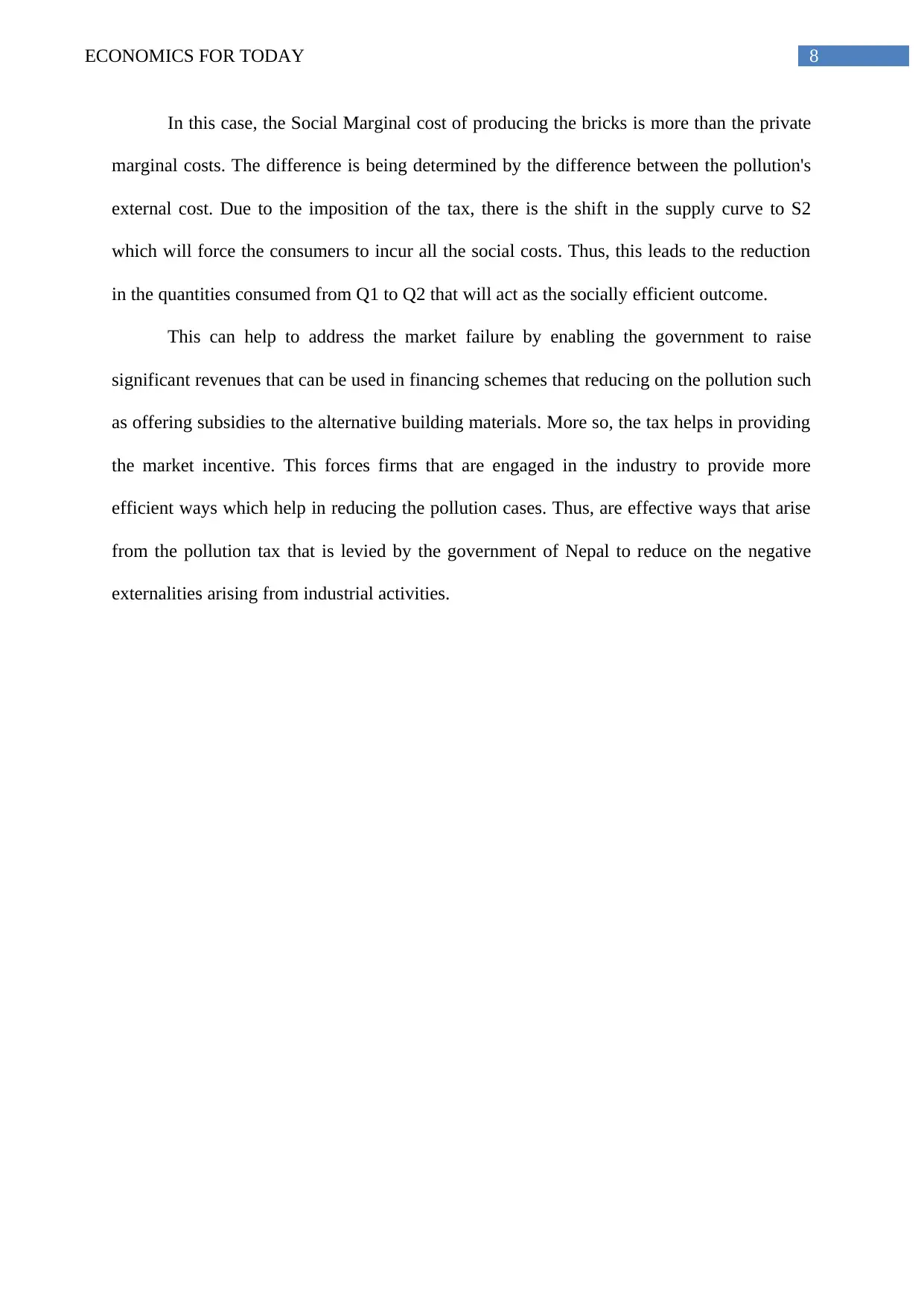
8ECONOMICS FOR TODAY
In this case, the Social Marginal cost of producing the bricks is more than the private
marginal costs. The difference is being determined by the difference between the pollution's
external cost. Due to the imposition of the tax, there is the shift in the supply curve to S2
which will force the consumers to incur all the social costs. Thus, this leads to the reduction
in the quantities consumed from Q1 to Q2 that will act as the socially efficient outcome.
This can help to address the market failure by enabling the government to raise
significant revenues that can be used in financing schemes that reducing on the pollution such
as offering subsidies to the alternative building materials. More so, the tax helps in providing
the market incentive. This forces firms that are engaged in the industry to provide more
efficient ways which help in reducing the pollution cases. Thus, are effective ways that arise
from the pollution tax that is levied by the government of Nepal to reduce on the negative
externalities arising from industrial activities.
In this case, the Social Marginal cost of producing the bricks is more than the private
marginal costs. The difference is being determined by the difference between the pollution's
external cost. Due to the imposition of the tax, there is the shift in the supply curve to S2
which will force the consumers to incur all the social costs. Thus, this leads to the reduction
in the quantities consumed from Q1 to Q2 that will act as the socially efficient outcome.
This can help to address the market failure by enabling the government to raise
significant revenues that can be used in financing schemes that reducing on the pollution such
as offering subsidies to the alternative building materials. More so, the tax helps in providing
the market incentive. This forces firms that are engaged in the industry to provide more
efficient ways which help in reducing the pollution cases. Thus, are effective ways that arise
from the pollution tax that is levied by the government of Nepal to reduce on the negative
externalities arising from industrial activities.
⊘ This is a preview!⊘
Do you want full access?
Subscribe today to unlock all pages.

Trusted by 1+ million students worldwide
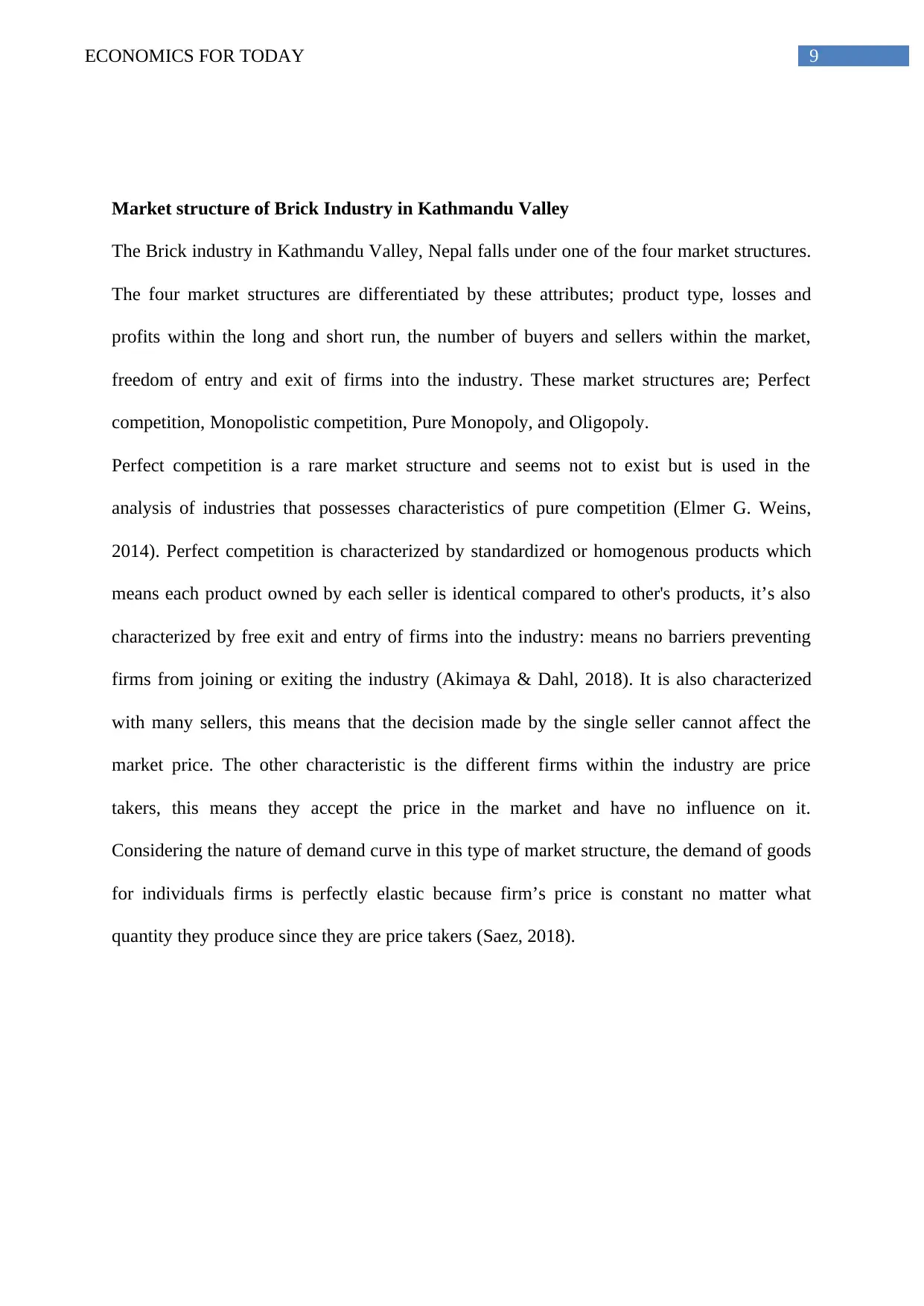
9ECONOMICS FOR TODAY
Market structure of Brick Industry in Kathmandu Valley
The Brick industry in Kathmandu Valley, Nepal falls under one of the four market structures.
The four market structures are differentiated by these attributes; product type, losses and
profits within the long and short run, the number of buyers and sellers within the market,
freedom of entry and exit of firms into the industry. These market structures are; Perfect
competition, Monopolistic competition, Pure Monopoly, and Oligopoly.
Perfect competition is a rare market structure and seems not to exist but is used in the
analysis of industries that possesses characteristics of pure competition (Elmer G. Weins,
2014). Perfect competition is characterized by standardized or homogenous products which
means each product owned by each seller is identical compared to other's products, it’s also
characterized by free exit and entry of firms into the industry: means no barriers preventing
firms from joining or exiting the industry (Akimaya & Dahl, 2018). It is also characterized
with many sellers, this means that the decision made by the single seller cannot affect the
market price. The other characteristic is the different firms within the industry are price
takers, this means they accept the price in the market and have no influence on it.
Considering the nature of demand curve in this type of market structure, the demand of goods
for individuals firms is perfectly elastic because firm’s price is constant no matter what
quantity they produce since they are price takers (Saez, 2018).
Market structure of Brick Industry in Kathmandu Valley
The Brick industry in Kathmandu Valley, Nepal falls under one of the four market structures.
The four market structures are differentiated by these attributes; product type, losses and
profits within the long and short run, the number of buyers and sellers within the market,
freedom of entry and exit of firms into the industry. These market structures are; Perfect
competition, Monopolistic competition, Pure Monopoly, and Oligopoly.
Perfect competition is a rare market structure and seems not to exist but is used in the
analysis of industries that possesses characteristics of pure competition (Elmer G. Weins,
2014). Perfect competition is characterized by standardized or homogenous products which
means each product owned by each seller is identical compared to other's products, it’s also
characterized by free exit and entry of firms into the industry: means no barriers preventing
firms from joining or exiting the industry (Akimaya & Dahl, 2018). It is also characterized
with many sellers, this means that the decision made by the single seller cannot affect the
market price. The other characteristic is the different firms within the industry are price
takers, this means they accept the price in the market and have no influence on it.
Considering the nature of demand curve in this type of market structure, the demand of goods
for individuals firms is perfectly elastic because firm’s price is constant no matter what
quantity they produce since they are price takers (Saez, 2018).
Paraphrase This Document
Need a fresh take? Get an instant paraphrase of this document with our AI Paraphraser
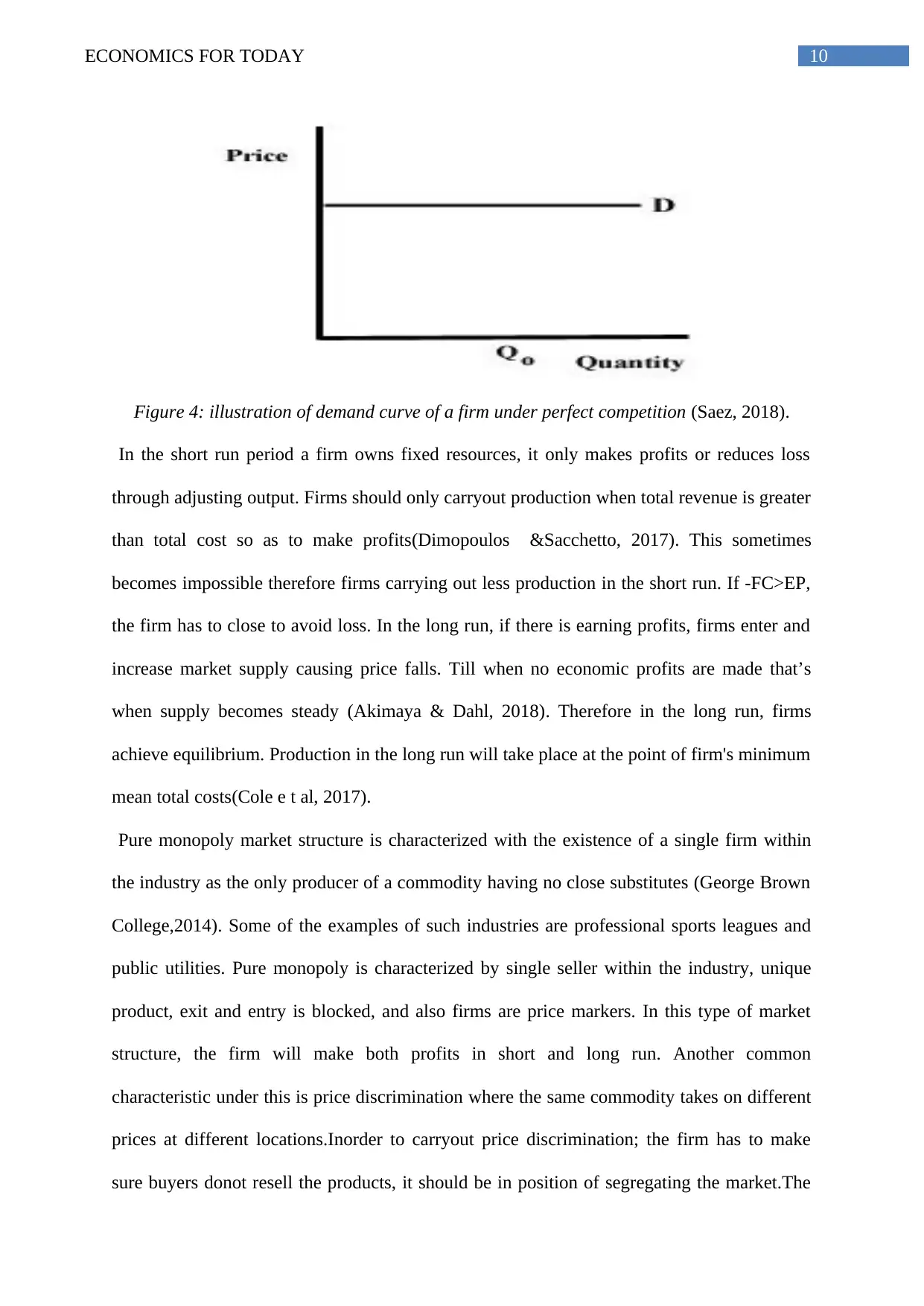
10ECONOMICS FOR TODAY
Figure 4: illustration of demand curve of a firm under perfect competition (Saez, 2018).
In the short run period a firm owns fixed resources, it only makes profits or reduces loss
through adjusting output. Firms should only carryout production when total revenue is greater
than total cost so as to make profits(Dimopoulos &Sacchetto, 2017). This sometimes
becomes impossible therefore firms carrying out less production in the short run. If -FC>EP,
the firm has to close to avoid loss. In the long run, if there is earning profits, firms enter and
increase market supply causing price falls. Till when no economic profits are made that’s
when supply becomes steady (Akimaya & Dahl, 2018). Therefore in the long run, firms
achieve equilibrium. Production in the long run will take place at the point of firm's minimum
mean total costs(Cole e t al, 2017).
Pure monopoly market structure is characterized with the existence of a single firm within
the industry as the only producer of a commodity having no close substitutes (George Brown
College,2014). Some of the examples of such industries are professional sports leagues and
public utilities. Pure monopoly is characterized by single seller within the industry, unique
product, exit and entry is blocked, and also firms are price markers. In this type of market
structure, the firm will make both profits in short and long run. Another common
characteristic under this is price discrimination where the same commodity takes on different
prices at different locations.Inorder to carryout price discrimination; the firm has to make
sure buyers donot resell the products, it should be in position of segregating the market.The
Figure 4: illustration of demand curve of a firm under perfect competition (Saez, 2018).
In the short run period a firm owns fixed resources, it only makes profits or reduces loss
through adjusting output. Firms should only carryout production when total revenue is greater
than total cost so as to make profits(Dimopoulos &Sacchetto, 2017). This sometimes
becomes impossible therefore firms carrying out less production in the short run. If -FC>EP,
the firm has to close to avoid loss. In the long run, if there is earning profits, firms enter and
increase market supply causing price falls. Till when no economic profits are made that’s
when supply becomes steady (Akimaya & Dahl, 2018). Therefore in the long run, firms
achieve equilibrium. Production in the long run will take place at the point of firm's minimum
mean total costs(Cole e t al, 2017).
Pure monopoly market structure is characterized with the existence of a single firm within
the industry as the only producer of a commodity having no close substitutes (George Brown
College,2014). Some of the examples of such industries are professional sports leagues and
public utilities. Pure monopoly is characterized by single seller within the industry, unique
product, exit and entry is blocked, and also firms are price markers. In this type of market
structure, the firm will make both profits in short and long run. Another common
characteristic under this is price discrimination where the same commodity takes on different
prices at different locations.Inorder to carryout price discrimination; the firm has to make
sure buyers donot resell the products, it should be in position of segregating the market.The
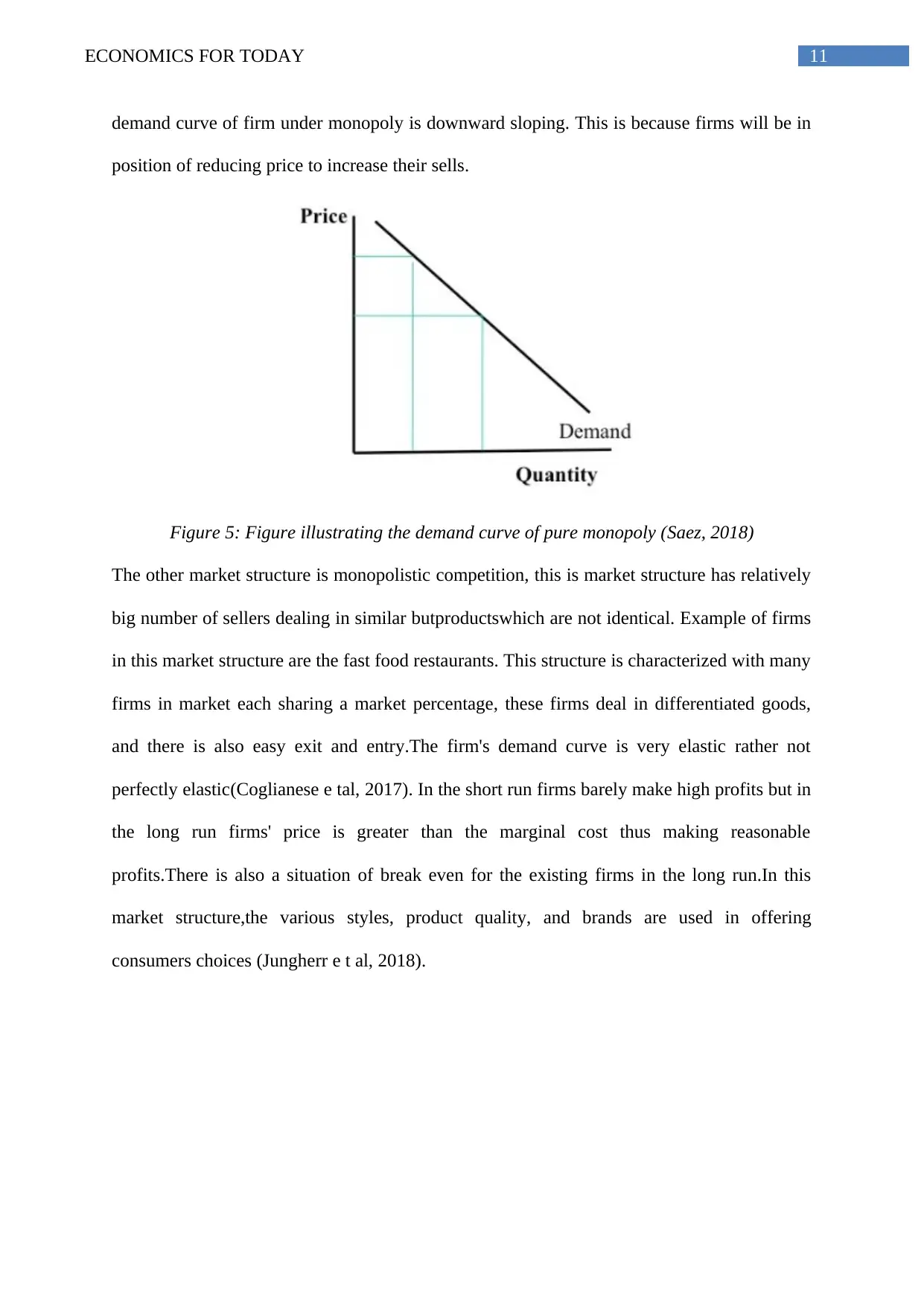
11ECONOMICS FOR TODAY
demand curve of firm under monopoly is downward sloping. This is because firms will be in
position of reducing price to increase their sells.
Figure 5: Figure illustrating the demand curve of pure monopoly (Saez, 2018)
The other market structure is monopolistic competition, this is market structure has relatively
big number of sellers dealing in similar butproductswhich are not identical. Example of firms
in this market structure are the fast food restaurants. This structure is characterized with many
firms in market each sharing a market percentage, these firms deal in differentiated goods,
and there is also easy exit and entry.The firm's demand curve is very elastic rather not
perfectly elastic(Coglianese e tal, 2017). In the short run firms barely make high profits but in
the long run firms' price is greater than the marginal cost thus making reasonable
profits.There is also a situation of break even for the existing firms in the long run.In this
market structure,the various styles, product quality, and brands are used in offering
consumers choices (Jungherr e t al, 2018).
demand curve of firm under monopoly is downward sloping. This is because firms will be in
position of reducing price to increase their sells.
Figure 5: Figure illustrating the demand curve of pure monopoly (Saez, 2018)
The other market structure is monopolistic competition, this is market structure has relatively
big number of sellers dealing in similar butproductswhich are not identical. Example of firms
in this market structure are the fast food restaurants. This structure is characterized with many
firms in market each sharing a market percentage, these firms deal in differentiated goods,
and there is also easy exit and entry.The firm's demand curve is very elastic rather not
perfectly elastic(Coglianese e tal, 2017). In the short run firms barely make high profits but in
the long run firms' price is greater than the marginal cost thus making reasonable
profits.There is also a situation of break even for the existing firms in the long run.In this
market structure,the various styles, product quality, and brands are used in offering
consumers choices (Jungherr e t al, 2018).
⊘ This is a preview!⊘
Do you want full access?
Subscribe today to unlock all pages.

Trusted by 1+ million students worldwide
1 out of 19
Related Documents
Your All-in-One AI-Powered Toolkit for Academic Success.
+13062052269
info@desklib.com
Available 24*7 on WhatsApp / Email
![[object Object]](/_next/static/media/star-bottom.7253800d.svg)
Unlock your academic potential
Copyright © 2020–2025 A2Z Services. All Rights Reserved. Developed and managed by ZUCOL.





